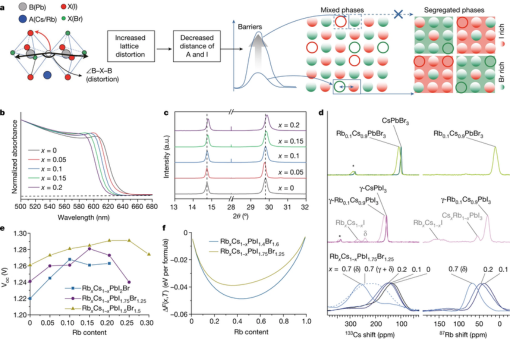Suppressed phase segregation for triple-junction perovskite solar cells
Abstract
The tunable bandgaps and facile fabrication of perovskites make them attractive for multi-junction photovoltaics1,2. However, light-induced phase segregation limits their efficiency and stability3–5: this occurs in wide-bandgap (>1.65 electron volts) iodide/bromide mixed perovskite absorbers, and becomes even more acute in the top cells of triple-junction solar photovoltaics that require a fully 2.0-electron-volt bandgap absorber2,6. Here we report that lattice distortion in iodide/bromide mixed perovskites is correlated with the suppression of phase segregation, generating an increased ion-migration energy barrier arising from the decreased average interatomic distance between the A-site cation and iodide. Using an approximately 2.0-electron-volt rubidium/caesium mixed-cation inorganic perovskite with large lattice distortion in the top subcell, we fabricated all-perovskite triple-junction solar cells and achieved an efficiency of 24.3 per cent (23.3 per cent certified quasi-steady-state efficiency) with an open-circuit voltage of 3.21 volts. This is, to our knowledge, the first reported certified efficiency for perovskite-based triple-junction solar cells. The triple-junction devices retain 80 per cent of their initial efficiency following 420 hours of operation at the maximum power point.
Citation
Wang, Z., Zeng, L., Zhu, T. et al. Suppressed phase segregation for triple-junction perovskite solar cells. Nature 618, 74–79 (2023). https://doi.org/10.1038/s41586-023-06006-7


